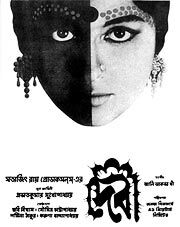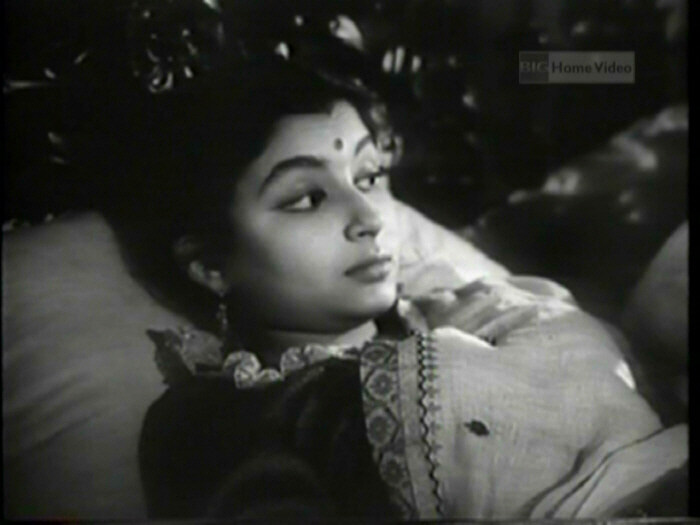
If you summarized the stories of all the movies, it would seem to be hoary old. All new kinds of films never tell a new story, but "show" it in a different way. Satyajit Ray, the great film director in India, did do.
Satyajit Ray had been known to "few" Korean moviegores for
only, and even, probably most of them haven't seen his works. There would be a lot of reasons, but sure thing is, Satyajit Ray and Idian films are uncharted territory to us. It would remain uncharted to me if my friends(Vijay, Aparna, and my brother-in-low Prem) didn't let me know and give me a present "Satyajit Ray's DVD Box Set". When I got it, I promised that I'd review each film as soon as watch it. And this is time to keep the promise. :)
<Devi (1960)> starts to show the process of how a simple model turning to be a Kali(a goddess in Hinduism) figure. This scene looks stunning (even don't know of Hindu religion), and implies what story goes on.




In 1860 at Chandipur, in rural Bengal, India(On the DVD, can't find any information about region and era. They're taken from satyajitray.org.), Daya and her husband Uma live with Uma's family. His father is a respected landlord and a devotee of the goddess Kali. Since Uma is away at school (to pass the exam), Daya looks after her father-in-law and his family. One evening, Uma's father has a dream that Daya is an incarnation of Kali and must be worshipped as such. After hearing the news, Uma returns home but is unable to correct the situation because Daya herself begins to believe that she is a goddess Kali. And her belief turns to tragedy.
<Devi> continually contrasts humanity and divinity, true nature and illusion, weak belief and blind faith, modernity and tradition (saying more, other religion[Christianity] and Hinduism, new generation and old one, belief and hope). You don't need to study of Hindu religion or Indian Myth to watch this film (If you know, will be more interesting, but that's not the theme). Satyajit Ray asks, if blind faith and miracle happened simultaneously, what would you do? Can you choose the right thing? Are you sure and confident who you are and what you're doing?
In the film, Daya is a normal housewife (and only 17 years old!) but because of her father-in-law's vision(in fact, just dream!), she turns to be a living statue like a stone. However, she does a miracle(actually, coincidence) and beings to think "maybe" she is the goddess. And her blindness makes herself from the goddess to the demon. When breaking her faith, she looks mad. The uncertain faith can't maintain humans themselves. Satyajit Ray describes the weak human being. To support an imperfect human nature, we have a religion, but ironically, it could destroy us (like Kali does, who destroys). Yes, now I understood Vijay's saying. "Satyajit Ray is Akira Kurosawa in India." I totally agree with him, even though I've just watched only one movie. <Devi> is touching and twisting something inside me. I'm looking forward to finding what they are through watching Satyajit Ray's films.





About the DVD, <Devi>'s picture quality is "disastrous", and all English subtitles are fixed (and some subtitles are missing). But, they're not bothering me (and my wife) to watch it because the movie's so great! To meet Satyajit Ray, this would be the magnificent thing among "the Top 5" in my life.
Devi (Devanagari: देवी) is the Sanskrit word for Goddess, used mostly in Hinduism. Devi is synonymous with Shakti, the female aspect of the divine, as conceptualized by the Shakta tradition of Hinduism. She is the female counterpart without whom the male aspect, which represents consciousness or discrimination, remains impotent and void. Goddess worship is an integral part of Hinduism.
Devi is, quintessentially, the core form of every Hindu Goddess. As the female manifestation of the supreme lord, she is also called Prakriti, as she balances out the male aspect of the divine addressed Purusha.
Devi is the supreme Being in the Shaktism tradition of Hinduism, while in the Smartha tradition, she is one of the five primary forms of God. In other Hindu traditions of Shaivism and Vaishnavism, Devi embodies the active energy and power of male deities (Purushas), such as Vishnu in Vaishnavism or Shiva in Shaivism. Vishnu's shakti counterpart is called Lakshmi, with Parvati being the female shakti of Shiva.
From http://en.wikipedia.org/wiki/Devi
Kālī (Sanskrit: काली, IPA: [kɑːliː]; Bengali: কালী; Tamil: காளி), also known as Kalika (Bengali: কালিকা, Kālikā), is the Hindu goddess associated with eternal energy. "She who destroys".The name Kali comes from kāla, which means black, time, death, lord of death, Shiva. Kali means "the black one". Since Shiva is called Kāla - the eternal time, Kālī, his consort, also means "the Time" or "Death" (as in time has come). Hence, Kali is considered the goddess of time and change. Although sometimes presented as dark and violent, her earliest incarnation as a figure of annihilation still has some influence. Various Shakta Hindu cosmologies, as well as Shakta Tantric beliefs, worship her as the ultimate reality or Brahman. She is also revered as Bhavatarini (literally "redeemer of the universe"). Comparatively recent devotional movements largely conceive Kali as a benevolent mother goddess.
Kali is represented as the consort of Lord Shiva, on whose body she is often seen standing. She is associated with many other Hindu goddesses like Durga, Bhadrakali, Sati, Rudrani, Parvati and Chamunda. She is the foremost among the Dasa Mahavidyas, ten fierce Tantric goddesses.
From http://en.wikipedia.org/wiki/Kali